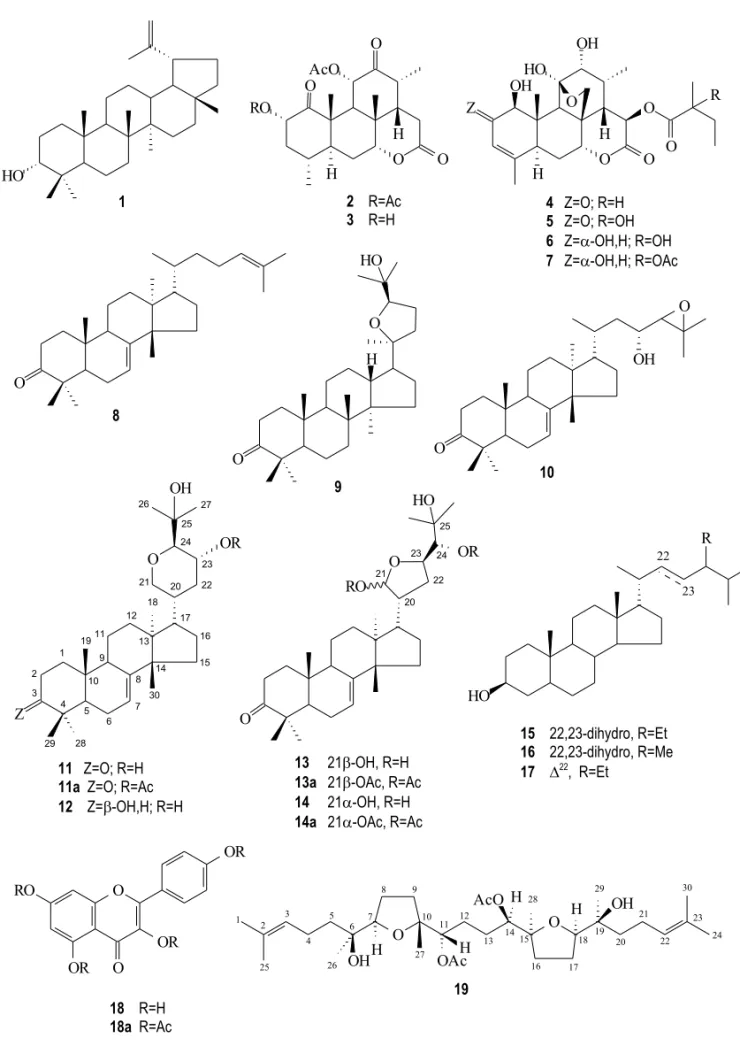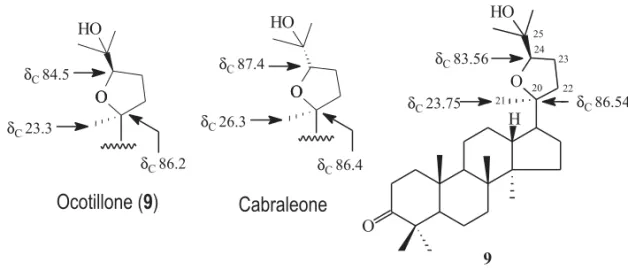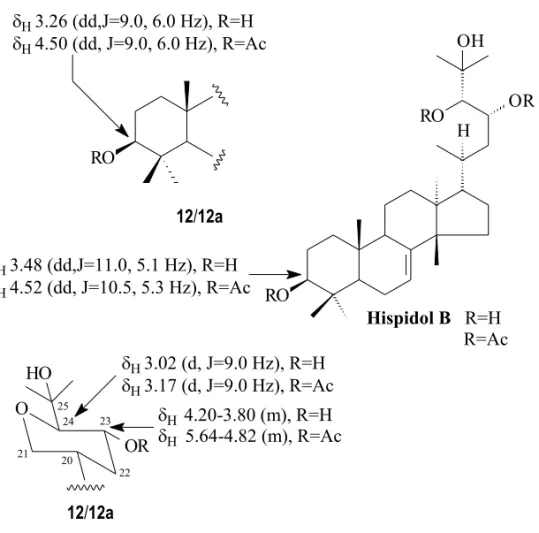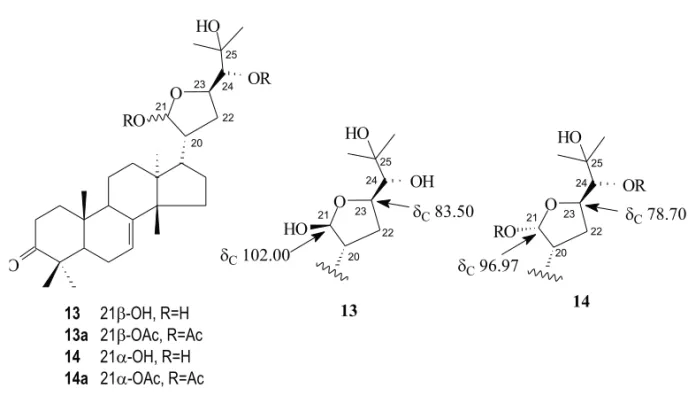www.scielo.br/aabc
Chemical constituents of
Simarouba versicolor
ANGELA M.C. ARRIAGA1, ALDENOR C. DE MESQUITA1, YVONE B.M. POULIQUEN1, ROBERTO A. DE LIMA2, SERGIO H. CAVALCANTE2, MARIO G. DE CARVALHO3,
JOSÉ A. DE SIQUEIRA3, LEILA V. ALEGRIO3 and RAIMUNDO BRAZ-FILHO4
1Departamento de Química Orgânica e Inorgânica, Centro de Ciências,
Universidade Federal do Ceará, Cx. Postal 12200, 60021-970 Fortaleza, Ceará, Brasil
2Departamento de Química, Universidade Federal de Alagoas, Maceió, Alagoas, Brasil 3Departamento de Química – ICE, Universidade Federal Rural do Rio de Janeiro
Seropédica, Rio de Janeiro, Brasil
4Setor de Química de Produtos Naturais – LCQUI – CCT, Universidade Estadual do Norte Fluminense
28015-620 Campos, Rio de Janeiro, Brazil
Manuscript received on March 20, 2001; accepted for publication on December 3, 2001; contributed byRaimundo Braz-Filho*
ABSTRACT
From the roots, stems and fruits ofSimarouba versicolor(Simaroubaceae) were isolated quassinoids (3, 5-7), triterpenoids (8-14), a mixture of steroids (15-17), the flavonoid kaempferol (18) and the squalene derivative 11,14-diacetoxy-7,10; 15,18-diepoxy-6,19-dihidroxy-6,7,10,11,14,15,18,19-octahydrosqualene (19). Spec-tral data were used for structural characterization.
Key words:Simarouba versicolor, Simaroubaceae, quassinoids, triterpenoids, steroids, flavonoid, squalene derivative.
INTRODUCTION
Some species of the small family Simaroubaceae (28 genera containing 25 species of tropical and semitropical shrubs and trees) have furnished wood for construction and others have been used in folk medicine. In the last few years, the therapeutic pur-poses have increased because of its antimalarial, tiinflammatory, antileukemic, antifeedant, and an-tiviral activities (Engler and Prantl 1872). In Brazil, the Simaroubaceae family is represented by the gen-eraQuassiaandPicrolemma, in the Amazonian Re-gion,CastelaandPicrasma, in the south of the coun-try, andSimaba,SimaroubaandPicrolemmawhich are present throughout Brazil (Hall et al. 1983).
Correspondence to: Raimundo Braz-Filho E-mail: braz@uenf.br
*Member of Academia Brasileira de Ciências
Species of the genusSimaroubahave been reported previously as bioproducers of anticancer, antiviral, antimalaric, antiinflammatory (Polonsky 1973), in-secticide and amoebacide agents (Polonsky 1985). This latter species has been used in the traditional medicine and is very known in China and Mexico.
Epilupeol (1), four quassinoids (2-5) and β-sitosterol (15) were previously isolated from the leaves and stems of a specimen ofSimarouba versi-colorcollected in the State of Paraná, Brasil (Ghosh et al. 1977).
416 ANGELA M.C. ARRIAGA et al.
State of Ceará, in the northeastern of Brazil. This region has a very distinct climate, which is different from the place where the specimen was collected for the previous investigation. The structures of the compounds reported in this paper were established on the basis of spectral data, including 2D NMR experiments of19.
RESULTS AND DISCUSSION
The secondary metabolites isolated fromSimarouba versicolor, known quassinoids(3, 5-7), triterpenoids (8-14), a mixture of steroids (15-17), the flavonoid kaempferol (18) and squalene derivative (19), were identified by their IR, MS,1H and13C NMR data, in-cluding preparation of some acetyl derivatives (11a, 12a, 13a, 14a and18a) and comparison with lit-erature data (Merrien and Polonsky 1971, Connolly and McCrindle 1971, Polonsky et al. 1975, Kupchan and Lacadie 1975, Jolad et al. 1981, Suzuki et al. 1985, Hashimoto et al. 1988a,b). The characteri-zation of the squalene derivative19involved addi-tional results obtained by interpretation of homonu-clear and heteronuhomonu-clear 2D shift-correlated spec-tra facilitated by comparison with data reported in the literature (Itokawa et al. 1991, Morita et al. 1993). The compounds isolated fromS. versicolor (Fig. 1) reported in this paper were previously ob-tained from plants classified in the same or other genera of Simaroubaceae or other families.
11-Acetylamarolide (3) was isolated from a specimen ofS. versicolorcollected in Paraná, state located in the South of Brazil (Ghosh et al. 1977).
Glaucarubinone (5) (Alves-de-Lima et al. 1983, Alves-de-Lima et al. 1984, Polonsky et al. 1975) and glaucarubin (6) (Mesquita et al. 1997, Polonsky et al. 1975) were previously obtained from Simarouba glauca(Buckingham 1994a).
2’-Actylglaucarubin (7) (Alves-de-Lima et al. 1984) and tirucalla-7,24-dien-3-one (8) (Alves-de-Lima et al. 1983, Siqueira et al. 1985) were reported as bioproducts fromS. amara(Buckingham 1994b). 20,24 - Epoxy - 25 - hydroxydammaran - 3 - one (ocotillone,9) (Alves-de-Lima et al. 1982, Siqueira et al. 1985) was reported in the literature as a
con-stituent ofDipterus hispidus andDryanobulanops spp., The CH-24 epimer, cabraleone, has been iso-lated from Cabralea polytricha (Buckingham 1994c). The relative configurations of carbon atoms C-20 and CH-24 of9were deduced by comparison of the chemical shifts of CH-24 (δC83.56) and CH3 -21 (δC 23.75). The significant differences among values reported in the literature for these carbons (Fig. 2) in ocotillone [9: δC 84.3 (CH-24) andδC 23.3 (CH3-21)] and cabraleone [24-epiocotillone:
δC87.4 (CH-24) andδC26.3 (CH3-21)], two CH-24 epimeric compounds (Tanaka and Yahara 1978), were used to characterize the compound isolated fromS. versicoloras identical to9. The lower chem-ical shifts of CH-24 (δC 83.56) and CH3-21 (δC 23.75) observed in the13C NMR spectrum of9when compared with the corresponding values of cabra-leone (Fig. 2) can be explained by the reciprocal γ-effects of these carbon atoms in9.
24,25-Epoxy-23-hydroxytirucall-7-en - 3 - one (nilocitin,10) (Alves-de-Lima et al. 1982, Siqueira et al. 1985) was previously isolated fromSimaba cedron, Simaroubaceae (Vieira et al. 1998).
418 ANGELA M.C. ARRIAGA et al.
25 24
23
22 21
20
δC86.54
δC83.56
δC23.75
9
O
O HO
H O
HO
O O
HO
O
δC23.3
δC84.5
δC86.2 δC86.4
δC87.4
δC26.3
Ocotillone (
9
)
Cabraleone
Fig. 2 – Comparison of the13C chemical shifts of the CH-24 methine carbon and CH3-21 methyl of 9with values described in the literature (Tanaka and Yahara 1978) for ocotilone (9) and cabraleone (24-epiocotilone).
Fig. 3 – Comparison of the chemical shifts of C-20 to C-25 of11with the corresponding values of sapelin A (Z=α-OH,H; R=H) reported in the literature (Jolad et al. 1981. The coupling constant (J=9.0 Hz) observed for signals of11and11areveal an axial-axial interaction between H-24 and H-23.
21,23-Epoxy-21β,24,25-trihydroxytirucall- 7-en-3-one (13) and 21,23-epoxy-21 α ,24,25-trihy-droxytirucall-7-en-3-one (14) were isolated as a mixture, clearly recognizable by the signals ob-served in the13C NMR spectrum atδ
C102.00/96.97
Fig. 4 – Comparison of the1H chemical shifts of H-3 of12and12awith the corresponding values for hispidol B and its acetyl derivative reported in the literature (Jolad et al. 1981. The coupling constant (J =9.0 Hz) observed for signals of12and12areveal an axial-axial interaction between H-24 and H-23.
CH-23 by the hydroxyl group located at CH-21 and on CH-21 by the methine carbon CH-24 (Siqueira et al. 1985). Compound14was previously obtained fromSamadera madagascariensis, Simaroubaceae (Merrien and Polonsky 1971), when it was mainly characterized through 1H NMR spectral data. On the basis of the relative intensities of the signals cor-responding to H-21 in the 1H NMR spectrum the epimer 13(minor component) was now estimated as<10% in the mixture isolated fromSimarouba versicolor.
The presence of steroids15-17 in a mixture was mainly deduced by 13C NMR spectral data, which involved comparison with values reported in the literature (Blunt and Stother 1977, Chaurasia and Wichtl 1987). The peaks atm/z414 ([M]+. of15),
412 ([M]+. of17) and 400 ([M]+. of16) observed in the mass spectrum was also used for the identifi-cation of these compounds.
The flavonol kaempferol (18) obtained as its acetyl derivative (18a) (Arriaga et al. 1994) is fre-quently isolated of plants.
The number of linked hydrogens for each car-bon signal of19(mp 149.8-153.2oC) was deduced by comparative analysis of HBBD (30 singlet sig-nals corresponding to 34 carbon atoms) and DEPT-13C NMR [signals corresponding to 8 quaternary
420 ANGELA M.C. ARRIAGA et al.
Fig. 5 – Comparison of the13C chemical shifts of atoms CH-21 and CH-23 of13and14and deduction of the relative configurations.
groups atδC 21.13 and 21.07, in accordance with the singlet signals observed in the1H NMR atδH 2.03 and 2.04)] spectra (Table I). These data in com-bination with results obtained by1H NMR (1D and 2D1H-1H-COSY) and by heteronuclear 2D1H-13 C-COSY-nJ
CH(n=1, direct correlation via one bond – HETCOR –13C detected, conventional method; n=2 and 3, long-range spin-spin interaction – COLOC – 13C detected, conventional method) spectra and comparison with values reported in literature for eu-rylene (19) (Itokawa et al. 1991, Morita et al. 1993) were used to complete1H and 13C chemical shift assignments unambiguously. The differences ob-served in the comparison of the13C chemical shifts (Table I) may be attributed to mistakes previously re-ported using CDCl3as solvent (Itokawa et al. 1991), which was also used in our experiments, or to a sol-vent effect when the comparative analysis involves data obtained in CDCl3and pyridine-d5(Morita et al. 1993), as summarized in Table I. The13C NMR spectral data obtained in pyridine-d5(Morita et al. 1993) were used to eliminate the mistakes observed in the previous attribution when was used CDCl3 (Itokawa et al. 1991). However, the mistakes
corre-sponding to CH3-25/CH3-30 (δC17.58 and not 25.7 or 25.8), shielded as consequence of theγ-effect at-tributed to CH2-4/CH2-21, and CH3-1/CH3-24 (δC 25.24 and not 17.6 or 17.7), free of thisγ-effect, were maintained (Table I). On the basis of thisγ -effect, the ambiguous assignments may now be elim-inated, as shown in Table I. The results obtained by 1H-1H-NOE difference spectra (Table I) were also
used to confirm these data and to obtain stereochem-ical information on some stereogenic carbon atoms of19. The absolute configuration of eurylene (19), mp 146-148oC,[α]D+4.32◦, was established by X-ray analysis and Mosher’s method (Itokawa et al. 1991, Morita et al. 1993).
EXPERIMENTAL
General Experimental Procedure
TABLE I
1D and 2D1H and13C NMR spectral data for compound 19, in CDCl3and TMS as internal standard, compared with values (in parenthesis, in CDCl3and pyridine-d5respectively) described in the literature (Itokawa et al. 1991, Morita et al. 1993) for eurylene (19). Chemical shifts inδ(δHandδC, ppm) and coupling constants (J, in parenthesis) in Hz.*
δC δH 2JCH 3JCH
C –
2/23 131.54 (131.6, 130.9) – 3H-1, 3H-24/
3H-25, 3H-30
6 71.92 (83.6, 72.0) – 3H-26
10 83.55 (72.0, 84.1) – H-11, 3H-27
15 83.75 (72.7, 84.1) – H-14, 3H-28
19 72.64 (83.8, 72.5) – 3H-29
AcO 170.92 (n. d., 170.9) –
AcO 170.78 (n. d., 170.7) –
CH 1H-1H-NOE
3/22 124.43 (124.5, 125.8a/125.9a) 5.07 (t, 6.6) 3H-1, 3H-24/ 3H-25, 3H-30
7 86.52 (86.6, 87.1) 3.68 (dd, 5.5, 9.2) 3H-26
11 78.05 (78.2, 78.4) 4.83 (t, 7.0) 3H-27
14 77.51 (77.6, 78.1) 4.85 (t, 7.0) 3H-28
18 84.30 (84.60, 85.3) 3.74 (dd, 8.1, 6.8) 3H-29
CH2
4,21 22.03 (22.1, 22.7) 2.15-1.85 (m)
5 37.21 (37.3, 39.8) 1.45-1.25 (m) 3H-26
8 25.64 (25.8, 26.3) 2.05-1.95 (m), 1.80-1.70 (m) 9 34.77 (34.9, 35.1) 1.66-1.50 (m) 12 26.94 (27.1, 27.3b) 1.54 (m), 1.25 (m) 13 26.76 (26.9, 27.5b) 1.54 (m), 1.25 (m) 16 34.07 (34.2, 35.0) 1.96-1.82 (m), 1.58-1.46 (m) 17 25.47 (25.6, 26.3) 2.05-1.95 (m), 1.80-1.70 (m)
20 37.43 (37.6, 40.1) 1.45-1.25 (m) 3H-29
CH3
1/24 25.64 (17.6, 17.6c/17.7c) 1.65 (br s) 3H-25/3H30 H-3/H-22 (3%)
25/30 17.58 (25.7, 25.8) 1.58 (br s) 3H-1/3H-24
26 24.10 (24.2, 23.2) 1.14 (s) H-7(2%)
27 22.71 (22.8, 22.9) 1.12 (s) H-11(<1%)
28 22.50 (22.5, 22.1) 1.14 (s) H-14(<1%)
29 23.97 (24.0, 23.1) 1.15 (s) H-18(2%)
AcO 21.13 (n. d., 21.1) 2.03 (s) Aco 21.07 (n. d., 21.0) 2.04 (s)
422 ANGELA M.C. ARRIAGA et al.
(1H: 100 MHz; 13C: 25 MHz) spectrometers, us-ing CDCl3 and pyridin-d5as solvents; EIMS were recorded on Micro Mass instrument at 70 eV.
Plant Material
The roots, stems and fruits of S. versicolor were collected in Pacatuba in 1981 and Cascavel in 1997, respectively, Ceará State, Brazil and were identified by Professors Afranio Fernandes and E. Nunes, De-partamento de Biologia, Universidade Federal do Ceará (UFC), Fortaleza, Ceará, Brasil. A voucher specimen (number 20.795) has been deposited at Prisco Bezerra Herbarium, Departamento de Biolo-gia, UFC.
Extraction and Isolation
Dry and powdered roots (480g) were extracted, at room temperature, with hexane and following with acetone. The residue obtained from the acetone ex-tract, after evaporation of the solvent under vacuum, was chromatographed on a silica gel column to give the compounds 5 to13, 19 and a mixture of the steroids15,16and17(Alves-de-Lima et al. 1982, Alves-de-Lima et al. 1983, Alves-de-Lima et al. 1984, Siqueira et al. 1985).
The air-dried and powdered stems of S. ver-sicolor(4.0 kg) were extracted with hot EtOH in a Soxhlet system. The organic layer was concen-trated to give residue SVE (96.0g) which was fil-tered through 200g of silica gel 60 (Merck, 230-400 mesh) by elution with hexane, chloroform, ethyl acetate and methanol, furnishing after evaporation of the solvent SVH (13.4g), SVC (14.0g), SVAE (12.7g) and SVM (49.5g). SVH (7.5g) which were chromatographed over silica gel 60 (Merck, 230-400 mesh) column and eluted with hexane, chloro-form and ethyl acetate. The fractions eluted with CH3Cl/EtOAc mixture of increasing polarity, af-forded 19 (50.0 mg, mp. 149.8-153.2oC). SVC (5.6g) which was chromatographed over silica gel 60 (Merck, 230-400 mesh) column and eluted with hexane, chloroform and ethyl acetate mixtures of increasing polarity. The CH3Cl/EtOAc (20%) frac-tion furnished3(50.0 mg, mp. 158.1-159.3oC) after
recrystallization from methanol. SVAE (7.0 g) was chromatographed over silica gel 60 (Merck, 230-400 mesh) using pure hexane, mixture of hexane and chloroform, chloroform, ethyl acetate and methanol as solvents. The fractions eluted with EtOAc af-forded colorless crystals (30.0 mg) of6(mp. 240.6-241.6oC).
The fruits (500.0g) were crushed and extracted with hot ethanol in a Soxhlet system. The organic layer was concentrated to give SVFE (11.8g). This residue was chromatographed on 100.0g silica gel 60 (Merck, 230-400 mesh) and eluted with hexane, chloroform, ethyl acetate and methanol to furnish SVFAE (9.0g) and SVFM (2.7g). SVFAE (3.2g) was acetylated with Ac2O (32 mL) in the presence of pyridine (16 mL), at room temperature and stirred overnight. After the usual procedures, the product was extracted with Me2O and chromatographed on a silica gel 60 (Merck, 230-400 mesh) column and eluted with hexane, chloroform, ethyl acetate and methanol. After recrystallization from MeOH, the CH3Cl/EtOAc (10%) fraction furnished the acetyl derivative17a(50.0 mg, mp. 182.6-185.0oC).
ACKNOWLEDGMENTS
The authors are grateful to FUNCAP, FAPERJ and CNPq for grants and research fellowships; to Profes-sor Afranio Fernandes and E. Nunes, Departamento de Biologia, Universidade Federal do Ceará (UFC), Fortaleza, Ceará, Brasil for the botanical identifica-tion and to Prof. E.R. Silveira for the NMR spec-tra recorded by the technician Daniel Esdras Uchoa (M.Sc.).
RESUMO
Das raízes, galhos e frutos deSimarouba versicolorforam isolados quassinóides (3,5-7), triterpenóides (8-14), uma mistura de esteróides (15-17), o flavonóide canferol (18) e o derivado esqualênico
11,14-diacetoxi-7,10;15,18-die-póxi-6,19-diidroxi-6, 7, 10.11, 14, 15, 18, 19-octaidroes-qualeno (19). Dados espectrais foram usados para carac-terização estrutural.
quassinóides, triterpenóides, esteróides, flavonóide,
deri-vado esqualênico.
REFERENCES
Alves-de-Lima R, Cavalcante SH, Braz-Filho R and Alegrio LV.1982. Constituintes químicos de
Simarouba versicolor. Ciência e Cultura 34 (supl.): 519-519.
Alves-de-Lima R, Cavalcante SH, Alegrio LV, Geraldo-de-Carvalho M and Braz-Filho R. 1983. Constituintes químicos deSimarouba versi-color. Ciência e Cultura 35 (supl.): 447447.
Alves-de-Lima R, Cavalcante SH, Braz-Filho R; Geraldo-de-Carvalho M, Siqueira PS and Ale-grio LV.1984. Quassinóides deSimarouba versil-color. Ciência e Cultura 36 (supl.): 541-541.
Arriaga AMC, Mesquita AG and Braz-Filho R. 1994. Estudo químico dos frutos deSimarouba ver-sicolor. Livros de Resumos-SBQ: PN-85.
Blunt JW and Stother JB.1977.13C NMR Spectra of Steroids – A Survey and Commentary. Org Magn Reson 9: 439-464.
Buckingham J. Ed.1994a. Dictionary of Natural Prod-ucts, Chapman & Hall, London, vol. 3, p. 2555. 1994b, Vol. 5, p. 5638. 1994c. Vol. 2, p. 2063.
Chaurasia N and Wichtl M.1987. Sterols and Steryl Glycosides fromUrtica dioica. J Nat Prod 50: 881-885.
Connolly JD and McCrindle R. 1971. Tetranor-triterpenoids and Related Substances. Part III. The Constitution of Grandifoliolenone, anapo-Tirucallol Derivative fromKhaya grandifoliola(Meliaceae). J Chem Soc (C): 1715-1718.
Engler A and Prantl K.1872. Simaroubaceae. Mart Fl Bras. Munchen 12: 198-202.
Ghosh PC, Larrahondo JE, Quesne PW and Raf-fauf RF.1977. Antitumor Plants. IV. Constituents ofSimarouba versicolor. J Nat Prod 40: 364-369.
Hall IH, Lee KH, Imakura Y, Okano M and Johnson A.1983. Antiinflammatory Agents. III. Structure-activity relationships of brusatol and related quassi-noids. J Pharm Sci 72: 1282-1284.
Hashimoto M, Harigaya H, Yanagiya M and Shira-hama H.1988a. A Short Step Synthesis of Teurilene. Stereocontrolled Sequential Double Cyclization of
the C30-tetraenetetraol to the Tandem Tetrahydrofu-ran System. Tetrahedron Letters 29: 5947-5948.
Hashimoto M, Yanagiya M and Shirahama H.1988b. Total Synthesis ofmeso-Triterpene Ether, Teurilene. Chem Letters: 645-646.
Itokawa H, Kishi E, Morita H, Takeya K and Iitaka Y.1991. Eurylene, a New Squalene-type Triterpene fromEurycoma longifolia. Tetrahedron Letters 32: 1803-1804.
Jolad SD, Hoffmann JJ, Schram KH, Cole R, Tem-pesta MS and Bates RB.1981. Constituents of
Trichilia hispida(Meliaceae). 4. Hispidols A and B, Two New Tirucallane Triterpenoids. J Org Chem 46: 4085-4088.
Kupchan SM and Lacadie JÁ.1975. Dehydroailanthi-none, a New Antileukemic Quassinoid from Pierre-odendron kerstingii. J Org Chem 40: 654-657.
Merrien A and Polonsky J.1971. The Natural Occur-rence of Melianodiol and Its Diacetate in Samadera madagascariensis (Simaroubaceae): Model Experi-ments on Melianodiol Direct towards Simarolide. J C S Chem Commun: 261-262.
Mesquita AG, Arriaga AMC, Oliveira FA and Braz-Filho R. 1997. Quassinóide deSimarouba versi-color. Livros de Resumos-SBQ: PN-028.
Morita H, Kishi E, Takeya K, Itokawa H and Iitaka Y.1993. Squalene Derivatives fromEurycoma longi-folia. Phytochemistry 34: 765-771.
Okorie DA and Taylor DAH.1977. Triterpenes from seeds ofEntandrophragmaspecies. Phytochemistry 16: 2029-2030.
Polonsky J. 1973. Quassinoid Bitter Principles. Fortschr Chem Org Nat 30: 101-150.
Polonsky J. 1985. Quassinoid Bitter Principles II. Fortschr Chem Org Nat 47: 221-264.
Polonsky J, Baskévitch Z, Gottlieb HE, Hagaman EW and Wenkert E. 1975. Carbon-13 Nuclear Magnetic Resonance SpectralAnalysis of Quassinoid Bitter Principles. J Org Chem 40: 2499-2504.
Siqueira JAP, Braz-Filho R, Alves-de-Lima R and Cavalcante SH.1985. 3-Hidroxitriterpenóide iso-lado deSimarouba versicolor. Ciência e Cultura 37 (supl.): 519-519.
424 ANGELA M.C. ARRIAGA et al.
Teurilene and Thyrsiferyl 23-Acetate,mesoand re-markably Cytotoxic Compounds from the Marine Red Alga Laurencia obtusa(Hudson) Lamouroux. Tetrahedron Letters 26: 1329-1332.
Tanaka O and Yahara S.1978. Dammarane saponins of leaves ofPanax pseudo-ginsengsubsp. himaila-cus. Phytochemistry 17: 1353-1358.



